It’s not often that hydronics is breaking news at a metro TV station. WGAL 8 is an NBC affiliate based in Lancaster, PA. Since its inception in 1949, the station has covered worldwide accomplishments and calamity, several wars and the partial meltdown of the nearby Three Mile Island nuclear power plant, among countless other stories.
However, hydronics? It wasn’t exactly breaking news, but WGAL’s old boilers—and a wide range of other mechanical equipment—had reached retirement age. They’d served the facility well, but it was now time to replace them.
As luck would have it, facility managers invited the expert opinion of Ken Kauffman, professional engineer and President of Lancaster-based Moore Engineering Co., prior to the onset of the COVID-19 pandemic in 2020. Just as WGAL was preparing to implement Moore Engineering’s recommendations for a comprehensive building system upgrade, the pandemic hit. The TV station, like many others around the country, shifted their operations to mainly remote locations. “The station was mostly empty for more than a year,” said Kauffman.
In the months leading up to the pandemic, Moore Engineering had prepared detailed reports of system performance, with carefully mapped projections of how its retrofit design would improve energy efficiency and mechanical system performance.
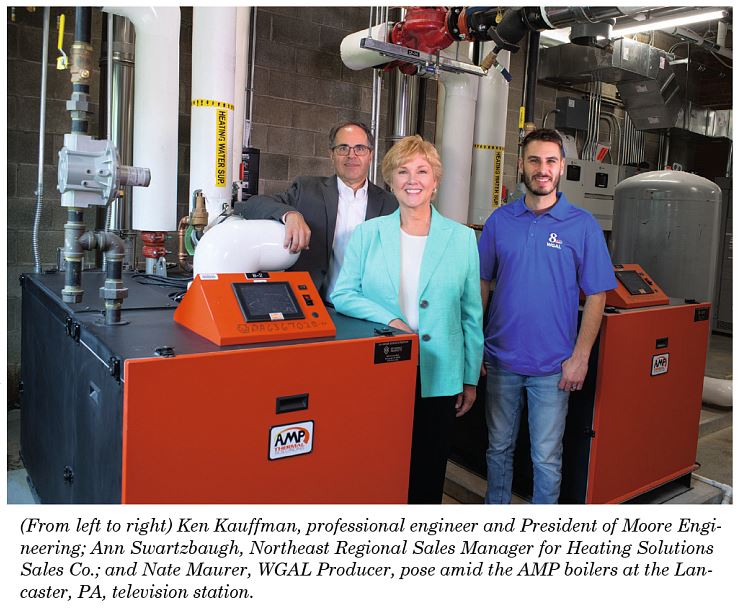
Under the magnifying glass: The entire facility
“We were hired to develop a plan to completely upgrade the HVAC systems in the facility,” explained Kauffman.
“The original building systems served the station well for decades, yet it was clear to us that modern building systems would dramatically enhance indoor air quality, operational and energy efficiency, comfort and sound—a facet of mechanical system operation that’s often overlooked.”
The engineering firm’s evaluations of mechanical, electrical and plumbing (MEP) systems were expanded to include the entire structure at precisely a time when another coincidence happened: managers recognized the need for sweeping renovations to the facility’s interior. This would entail an effort to modernize the building’s studios, offices, workspaces and a grand entry area. The building served the TV station’s needs well, but the investment in their high-level TV programming and news coverage had always taken precedence.
“Our assessment of WGAL’s building included walls, roof, insulation, lighting and accessibility,” added Kauffman.
“The sort of work we proposed would create a lot of dirt and noise—not conducive to live TV/News coverage. You simply can’t shut down the news. That’s a key reason why the building hadn’t been renovated in decades.”
Ultimately, the recommendations offered by Moore Engineering were accepted and served as the blueprint to a thorough modernization of the almost 60,000 sq ft facility. For the mechanical systems, all key parts and components were to be replaced. WGAL managers chose Gap, PA-based CMC, Inc. as the mechanical contractor to do the work. CMC’s role required an 18-month commitment; as a leading regional commercial MEP contracting firm, this was just the sort of work that fit nicely into their wheelhouse.
For the HVAC project, CMC acted as the general contractor and engaged multiple subs to perform the general construction such as structural work, walls, ceilings and painting. The MEP overhaul required replacement of the station’s chillers, boilers, pumps and air handlers. New variable air volume (VAV) systems were installed along with ductwork and controls.
Explained CMC’s Director of Operations, Eric Hodgdon, “There were four existing air handlers and two boilers in the facility that were replaced along with all of the heating and chilled water piping.”
This required much coordination and phasing to keep the facility conditioned throughout the project, according to Hodgdon, who said that CMC teams began their work in the lower level mechanical room and removed the two older cast iron boilers that were at the end of their service life. The crew then began installing new chillers, chilled water pumps and variable frequency drives (VFDs).
“When we turned on the new pumps and chillers, it allowed us to demo the old chilled water system on the second floor and also to install the new boilers and pumps,” he added.
The goal was to get the new boilers online before heating season in the Fall of 2020.
“This was made easy because of the compact design of the Thermal Solutions boilers,” Hodgdon continued, explaining that the small size allowed his team to rig the boilers through an existing window.
“The boilers’ integrated boiler control panel, high turndown and efficiency made it easy to phase in a replacement of the existing system,” he shared.
As the CMC teams completed newly finished areas, the boilers easily ramped up to meet the needs of the heating season.
“We used the existing piping and installed new valves to allow us to demo and replace piping while keeping the facility conditioned,” said Hodgdon.
CMC technicians mounted 7.5 hp pumps on vibration isolation pads to keep the transfer of mechanical noise to a minimum. Additionally, the use of VFDs and two-way control valves allowed for a much more energy efficient system, compared to the old constant volume system. Existing air handlers were replaced with Trane units and Trane VAVs.

“The new air handlers were disassembled on site and reassembled in the mechanical rooms in order to use existing openings in the building for rigging,” added Hodgdon.
According to Hodgdon, staging of temporary air handlers throughout the facility was necessary to keep engineering rooms at proper temperatures through the renovation.
“The WGAL staff was extremely accommodating and understanding throughout the whole process,” he shared.
Kauffman noted that there were initially four air handlers at WGAL. Now, there are five; an existing air handler was modified and the other three were replaced with four new ones.
“This assisted with phasing and offers greater flexibility when a unit needs to be shut down for maintenance,” he explained.
New boilers offer huge energy savings
Moore Engineering specified two 2,000 MBH condensing, natural gas-fired, Thermal Systems AMP boilers to replace WGAL’s aging boilers. The new, ultra-high efficiency, stainless steel boilers provide a 5:1 turndown, 97% efficiency, and required only half the square footage of the previous boilers.
Ann Swartzbaugh, Thermal Solutions Regional Manager, suggested that a small mechanical room on the second floor of the facility would easily accommodate the new AMP boilers.
“We’ve had plenty of previous experience with the AMP boilers and knew them to be an ideal fit for this application,” said Kauffman.
Dedicated to space heating needs at WGAL, the boilers send heated water to approximately 75 VAV boxes located throughout the TV station. According to Kauffman, there are five main air handlers that serve the HVAC needs of the building. All the VAV boxes and air handlers include hot water coils for heat and the systems provide year-round comfort at WGAL.
Ventilation was another important facet to the HVAC retrofit work, explained Kauffman.
“It was already on the list of needs to be addressed, but the COVID-19 pandemic spurred interest worldwide in the need for improved ventilation, and especially the introduction of fresh air. There’s no question that indoor air quality (IAQ) needs became a main focus through the planning process.”
Part of meeting those needs required a close look at air filtration.

“With the accommodation for continuous ventilation, we specified broad use of MERV 14 filters, which are designed to capture very small particulate and assist with maintaining clean air,” said Kauffman.
Kauffman noted that throughout the process, there were no real surprises. However, during the Summer of 2020, the need for face masks to continuously be worn at WGAL presented some discomfort for the technicians doing the work. As the station was essentially shut down, the pace of work accelerated and WGAL’s managers were nicely surprised with the reductions they saw immediately upon reoccupying the facility, such as the favorable drop in the cost of gas and electricity.
“A bit harder to discern were the vast improvements made to comfort and indoor air quality,” he added.
A significant contributor to the improved energy efficiency at WGAL happened as a result of the boiler replacement. According to Kauffman, the boiler efficiency went from 65–70% to the current mid- to high-90 percentile.
“The boiler plant played a major role in the total energy savings obtained in the project,” he noted.
Other contributing factors included new chillers, variable frequency drives, new insulation, improved controls, VAV systems, tighter ducts and LED lighting systems.
“The overall combined impact made an enormous difference in WGAL’s energy costs. Managers expressed a high level of satisfaction with the project and the new system’s performance,” Kauffman concluded. ICM
John Vastyan is CEO of Common Ground, based in Manheim, PA.
New York City still runs on steam heat. From the countless brownstones that line its streets to the high-rises and universities served by Con Edison’s steam utility, vaporized water reigns king in the five boroughs.
Saying that John Cataneo, Jr., and his brother, David, cut their teeth on cast iron steam boilers wouldn’t be a stretch. They were helping their father at work before their teen years. John Sr. founded Gateway Plumbing & Heating in the mid-1970s and the brothers took over in the late 1990s, carrying forward the legacy of quality and reliability.
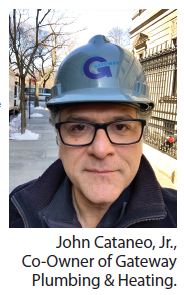
Gateway’s five trucks can be spotted in any New York City neighborhood, as often as not, hauling a steam boiler; they install 50 per year. As a residential and commercial company, word of mouth marketing is strong for Gateway, explained Cataneo Jr.
“Especially from one homeowner to another, because we quickly solve problems that are common among 100-year-old residential steam systems,” he said.
In-wall waterfalls
Gateway was referred to the owner of a two-family home in Brooklyn when their oversized oil boiler began leaking. The owner also reported uneven heat throughout the home and “waterfall noises” during heating season.
“The boiler had been repaired a dozen times and it just didn’t make financial sense to put another band-aid on it,” said Cataneo Jr.
“We gave them a bid to address the issues and started the work almost immediately.”
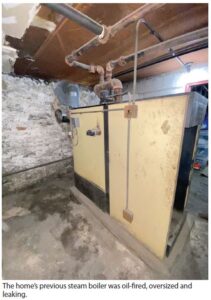
The home is four stories tall and divided into two residences—three landlord levels over one tenant space. Cosmetic renovations had been underway for four years. Its owners are recent immigrants from Germany, and steam heat was new to them, as was oil-fired heat.
“They had two options: keep the oil and we’d install a MegaSteam boiler, or convert to natural gas and install the new SteamMax, both made by U.S. Boiler Co.,” he explained.
Since the owners were familiar with gas, “We picked up a 175 MBH SteamMax,” Cataneo Jr. added.
Understanding steam
The existing boiler was a steel unit. After Cataneo Jr. performed an equivalent direct radiation (EDR) calculation, it became apparent that the boiler was oversized for the radiation in the home. Cataneo explained that the waterfall noise resulted from a condensate carryover issue. The old boiler and header weren’t effectively drying out the steam, leaving plenty of condensate within the system. The imbalanced heat was the result of old valves, traps and not enough air vents. Cataneo Jr. did find one nice surprise, however—the chimney had recently been lined.
“Once you really understand steam systems, the biggest challenge on this type of job is getting the old boiler out and the new boiler in,” he noted, adding that when dealing with homes built in the late 1800s or early 1900s, choices are rarely anything other than a small hatch cut into the foundation, or a narrow, often winding, sometimes unstable, staircase.
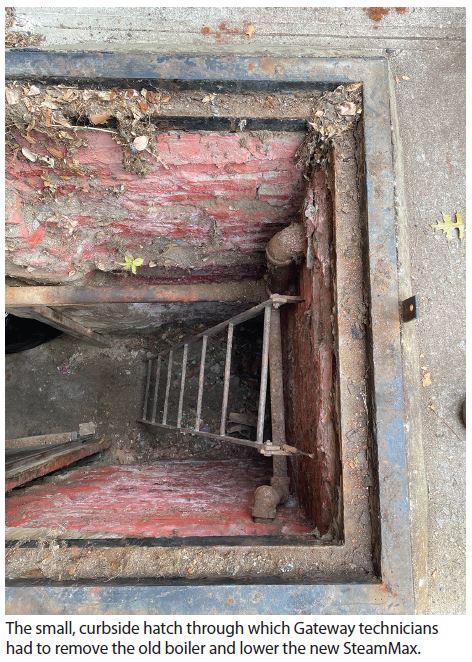
During the four-day install, Gateway provided a 50-gallon electric water heater for domestic hot water. Two technicians piped in a gas line, set the new boiler on concrete blocks, connected the boiler to an indirect water heater and assembled a new drop header.
Ideal configuration
According to Cataneo Jr., the SteamMax was very easy to install. The water heater was piped to a set of tappings below the water line for that purpose.
When designing the SteamMax, U.S. Boiler Co. included many features intended to make it more resilient to harsh water conditions, such as removing heat transfer pins at and above the water lines, widening waterways and replacing the conventional lance port burner with a high-tech stainless steel burner similar to those used on a modulating boiler.
“One unique feature of this boiler that I really appreciate is that the steam risers are not on the last cast iron section on either side of the boiler,” stated Cataneo Jr., noting that risers are instead placed on the penultimate sections, giving the installer an advantage since it reduces the length of the header.
“This means less pipe, but more importantly, the header occupies less width above the boiler, giving us more room to configure our system risers,” he noted.
“To me, this seems like a more natural place for the steam to exit, closer to the center of the boiler; this is because steam got into the header very quickly; the boiler seemed very responsive and it heated up more quickly than what I’ve come to regard as typical.”
Placing the risers closer to the center of the boiler also reduced water velocity, water impact and hot spots on the walls of end sections. This stabilized the waterline and reduced the repeated wetting and drying that can encourage chloride corrosion.
Dry steam & happy homeowners
Gateway also addressed the system imbalances throughout the home by adding two main air vents and swapping out old air vents on the radiators from room to room. Creating dry steam eliminated a great deal of the condensate carryover. Cataneo Jr. attributed this, at least in part, to the design of the new boiler, which includes a larger steam chest. With less water going into the header, there’s very good separation of steam from condensate before steam even leaves boiler.
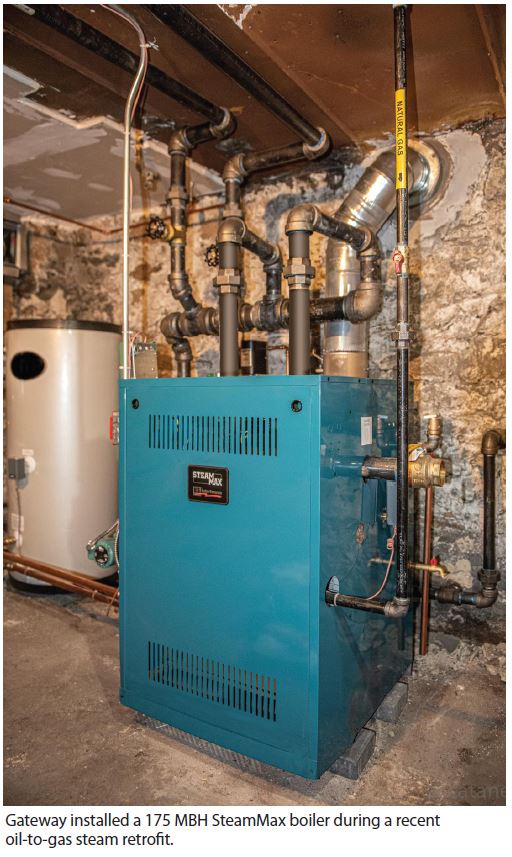
“The header takes care of the rest, but with the SteamMax, you’re starting from a healthier place; this is now my boiler of choice for gas-fired steam,” he added.
The homeowners are thrilled with their new system. Cataneo Jr. admits that they were skeptical at first, given the brand-new boiler design. Now, they’re over the moon with how warm, balanced, quiet and responsive the system is.
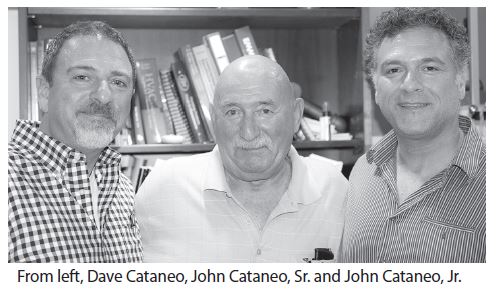
“There will be some fuel savings, but with the conversion to gas from oil, and with constant renovation going on in the home, it’ll be hard to quantify,” explained Cataneo Jr.
“We did reduce the installed capacity by more than 30%, and as all steam installers know, matching input to EDR is vital,” he concluded. ICM
Dan Vastyan is President of Common Ground, based in Manheim, PA.
For residential-only contractors, multi-family heating projects have a unique set of challenges. These jobs progress like commercial projects and need to be designed as such. Of course, they’re still residential in nature, but for the most part, it’s commercial work.
J.A.M. Plumbing & Heating, Inc. has built an interesting space within the skilled workforce of Rockland County, NY. The company, while smaller in comparison to most commercial/industrial contractors in New York, does very good work. The owner, Joe Mezzasalma, started the company in 2003.
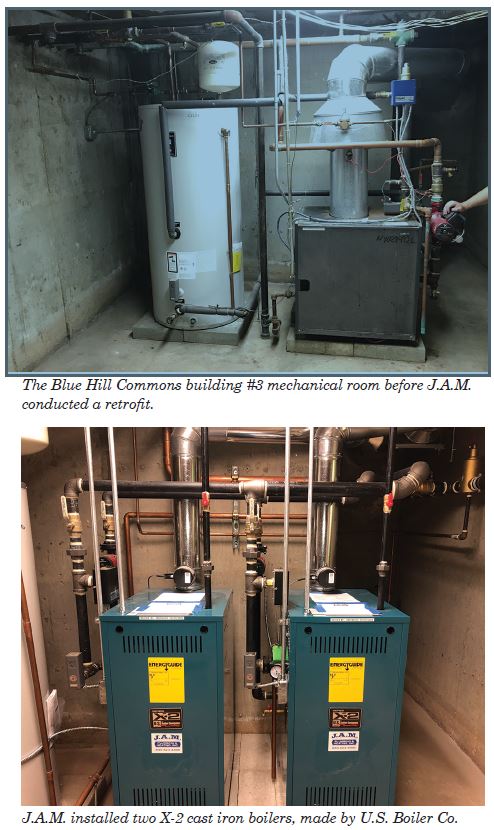
“People don’t hire J.A.M. if they’re simply price shopping,” said Tom Dwyer from rep firm Venco Sales, who has known Mezzasalma for 12 years.
“Joe is a craftsman. People hire him because they know he can make a difference.”
J.A.M. never works outside of Rockland County. In fact, the four-person crew, which includes Mezzasalma, is almost exclusive to five towns: Orangeburg, Sparkill, Tappan, Blauvelt and Piermont. There’s more than enough work there for the company without travelling further.
Multi-family service and replacement
One of J.A.M.’s areas of expertise is multi-family housing units, and there are plenty of them in Rockland County in the suburban areas. Blue Hill Commons, a condominium neighborhood built in the 1970s with 15 buildings, is one of them. It ranges in size from 4–12 units per building.
“We’ve done service work at Blue Hill Commons for more than a decade,” said Mezzasalma.
“Each year, we assess the health of the boiler systems and, if needed, schedule replacements.”
After 30 years in service, the boiler in Building #3 was showing its age. The nine-unit condo building was served by a single large boiler and an indirect tank. Fin tube radiation had been installed with zone valves on each apartment, one zone per apartment.
“Tom Dwyer visited the job with me in September of 2020,” said Mezzasalma.
“He sized and designed the new system. It was his idea to use two boilers instead of one, for efficiency and little redundancy.”
Dwyer’s plan was to install two, 140-MBH X-2 boilers, made by U.S. Boiler Co. Since the complex’s budget didn’t have room for condensing boilers, the new system could still have two stages of input by placing the cast iron Series X-2 boilers in a lead-lag-rotate configuration with an external staging control.
Work began in October and was finished in two weeks. Heat wasn’t needed at the time, and domestic hot water (DHW) was temporarily supplied with an electric water heater. The hardest part of the job was getting the old boiler out, and the new boilers in, since the basement mechanical room could only be accessed through a tight stairwell. The existing chimney was used to vent both X-2 boilers and J.A.M. installed a new, indirect water heater.
“This was out first time I used the X-2, and I’ll use it again,” said Mezzasalma.
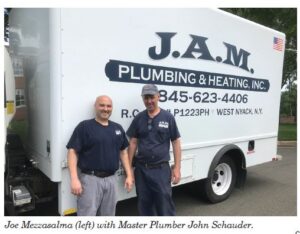
“It’s everything a cast iron boiler should be—simple yet compact, with easy-to-access controls.”
The Series X-2 is available in seven sizes from 70 to 280 MBH (MBH = 1,000 British Thermal Units [BTUs]). Design of the U.S.-made, cast iron heat exchanger promotes turbulent water flow for efficient heat transfer, providing an impressive 84% annual fuel utilization efficiency (AFUE).
With four of the Blue Hill Commons buildings tied to the same gas meter, there was no way to quantify gas savings. However, after one Winter in service, and a Winter when many residents stayed home, no complaints came in.
“No news is good news,” said Mezzasalma.
“You never get positive feedback, either, so silence is golden. I have to hand it to Tom [Dwyer] on the design of this system. He didn’t want to want to replace one large boiler with another single boiler, and I know, whether the gas savings are immediately evident or not, we’ll be saving gas in Building #3.”
Educational work
Shortly before J.A.M started the Blue Hill Commons project, the company was busy with a larger project at St. Thomas Aquinas College (STAC) in Sparkill, NY. An expansion at the college required a new dorm building.
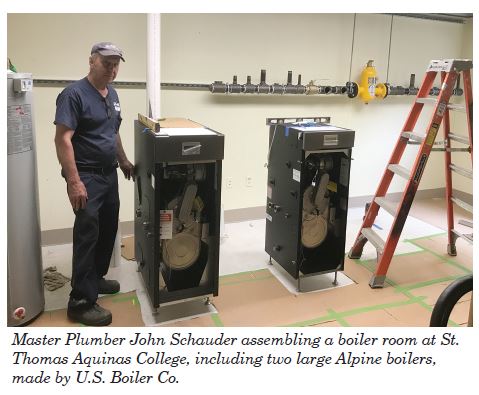
“We’re on the college’s preferred contractor list, so we got a call when they built the new 36-room dormitory,” said Mezzasalma.
“The engineer actually asked us which condensing boiler we preferred to use—U.S. Boiler Co.’s Alpine mod-con—and he then designed the system around that.”
J.A.M.’s work on the dorm included all plumbing in addition to the hydronic system, which serves the building’s common areas and provides DHW. The two common areas each include a fan coil unit, and individual dorm rooms are heated and cooled with packaged terminal air conditioner (PTAC) units.
Two 210-MBH Alpines boilers were installed on the second floor, along with a 34-gallon instantaneous indirect tank.
“Weight was a consideration for everything in the mechanical room, due to its second story location,” explained Mezzasalma.

“That’s one reason we installed the Alpine boilers and was also a consideration when the water heater was selected. The Alpine boilers each have a five-to-one firing ratio, so by pairing them, the system effectively has a 10–1 turndown. The 410 MBH input provides ample capacity to heat the space and create 15 gallons per minute (GPM) of domestic hot water. After all, there are 36 bathrooms in the building.
“Other than weight, we chose the Alpine because we trust the unit,” Mezzasalma continued.
“We’ve installed them in much larger multi-boiler systems before. The controls are great, it’s easy to service and it’s very efficient,” he said.
The project started in March of 2020 and culminated that August. The COVID-19 pandemic halted progress entirely at one point, and created scheduling conflicts throughout the project. Weather was an issue too, as heavy rain complicated the outdoor plumbing portion of the job.
When Dwyer conducted system start-up before the Fall 2020 semester began, the building was ready—whether the students would return to campus or learn from home.
Today, J.A.M. Plumbing & Heating, Inc. is currently installing two more Alpines at STAC and rezoning the Romano Student Center. Stellar craftsmanship, paired with solid product and design support, wins and keeps big customers. ICM
Dan Vastyan is President of Common Ground, based in Manheim, PA.
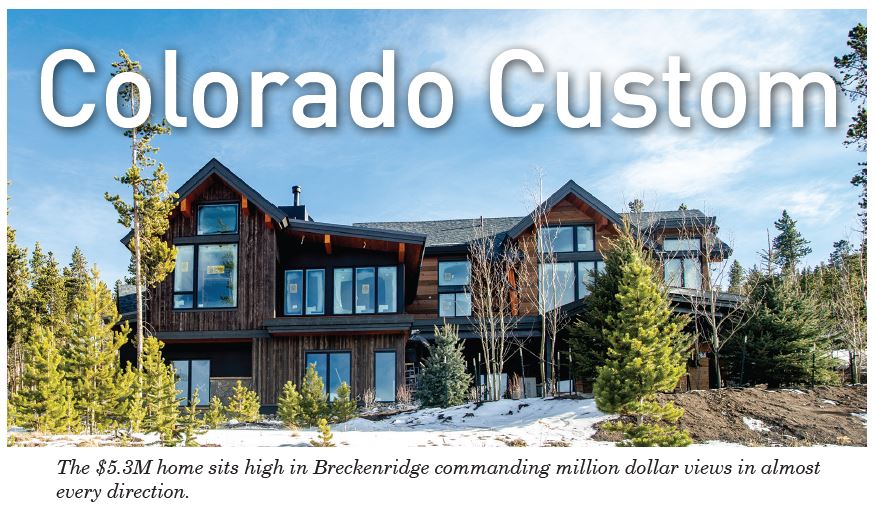
At 9,600 feet above sea level and only 75 miles from Denver, Breckenridge, CO, provides some of the best skiing in the U.S. The cool climate also means that most homes—even the big ones, and there are plenty of those—are not air conditioned.
The town’s official population is 5,000, but the true number of occupants swells considerably during ski season. A great number of the properties are vacation homes. Without a permanent population that correlates with the amount of property in the area, a number of services can tend to be in short order, especially in the skilled trades.
“The first time the building inspector in Breckenridge saw some of my work, he began propositioning me to set up shop here,” said Mike Holmes, Owner of Holmes Heating & Air. “My shop is in Denver, and this was the first time I’d done work in Breck.”
In addition to providing his qualifications, Holmes had to pay a $50 business license fee in order to work in Breckenridge.
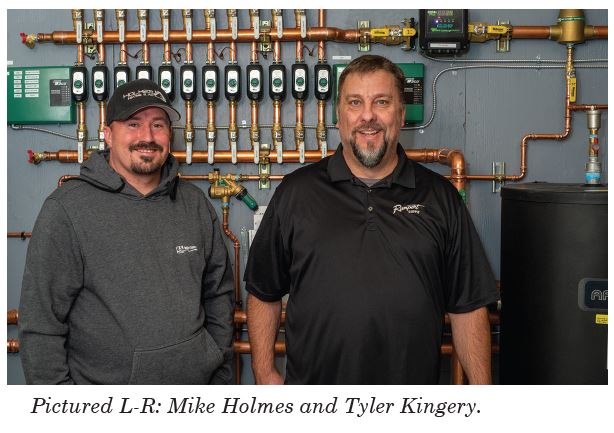
A referral in August of 2020 put Holmes in touch with Dave Farrell at FMJ Custom Build, LLC. The six-person general contracting firm has operated in Colorado for more than two decades, building livable custom homes and remodels with modern mountain designs and finishes.
Farrell asked Holmes to bid the hydronic system for a big home his company was building at the time, a unique residence with million dollar views. Before submitting his bid, Holmes visited the site three times to make sure his numbers were accurate. He was hired for the job—to complete a radiant system at the custom, 8,600 square-foot home perched high above a golf course.
Heating system work was begun by another contractor who moved out of the area. When he arrived, Holmes found various hydronic components in the mechanical room, some radiant tubing already laid and two energy recovery ventilation (ERV) systems that weren’t installed properly.
Throughout the entire process, Holmes leaned on Tyler Kingery at Rampart Supply in Pueblo, CO. As soon as Holmes had the signed contract, he hired several other tradesmen to join him and his brother to tackle the project while living out of a hotel in Breckenridge. Because the project was behind deadline when they took it over, Holmes and his crew completed a month’s worth of work in two weeks.
Challenges throughout
The race was on to get the heat running, given that drywall work couldn’t begin until the house was warm. Like the majority of upper echelon vacation homes in ski towns, the heating system would consist entirely of in-floor radiant. Premium comfort and ultra-high efficiency appeal to environmentally-minded vacationers.
The mechanical room was already stocked with a 399 MBH Aspen firetube boiler made by U.S. Boiler Co. Plenty of PEX, both in coils and already installed, was onsite. Holmes continued laying the half-inch Uponor PEX using a layout he created with Kingery.
“The existing PEX had been stapled down between sleepers,” said Holmes. “I prefer a panel system, but this works, and it gave us the flexibility to modify our tube spacing throughout the floorplan without specifying a variety of panel components.”
Most of the PEX was laid nine inches on center, though a few areas of concern were tighter than that. The master bedroom, for example, has a tongue-and-groove platform on which the bed rests. Here, and in tiled areas with northern exposure, tubing was installed on 6″ centers. In all, the home has 11 zones of heat, with a 12th installed, but not yet operational.
“There is no distinct first, second or third floor in this home,” said Holmes. “The levels of the house are all chopped up and fragmented with oddly-shaped rooms. This created a bunch of small zones and piping challenges to deal with. Open, vaulted ceilings made it more difficult to run supply and return lines, as well.”
Instead of asking Holmes to attempt fishing eight, three-quarter-inch lines through all variety of LVL and TJI joists, FMJ built a soffit for concealment. Uponor manifolds were installed throughout the home, typically in a wall with an access panel.
Flexible hydronics
The mechanical room was more straightforward than the rest of the home. A decent sized area was set aside solely for the boiler, indirect-fired water heater, buffer tank, pumps and valves.
Given the space to get creative, Holmes and Kingery had the freedom to specify anything they wanted, save the boiler.
“The Aspen condensing boiler was already here,” said Holmes. “It’s the boiler I would have selected anyway, but in a house this size, I’d likely have used two smaller models instead of one big one, just for more flexibility in firing rate. That said, with a 10:1 turndown and the use of a buffer tank, we still provide plenty of flexibility.”
The boiler loop and the system loop are both circulated by Taco Comfort Solutions’ 0034ePlus high efficiency pumps.
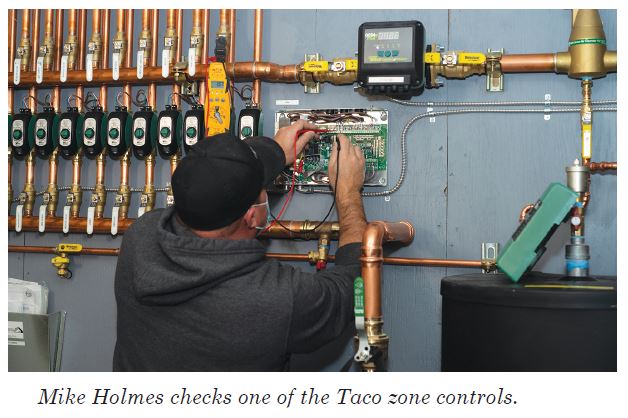
“We mounted one of the pumps horizontally and one vertically,” said Holmes. “We rotated the control box on the vertical pump for ease of use and appearance. Tyler Kingery was instrumental in helping me design the piping schematic for the house.”
For domestic hot water, a 110-gallon indirect tank was installed off the boiler, and the plumber connected a stainless steel hot water recirculation pump.
“Instead of installing a mixing valve, I used a 40 gallon buffer tank, which we maintain at 125°F,” said Holmes. “The boiler modulates via the outdoor reset, with an outdoor design temp of 0°F.” The smallest zone in the house is a 10′ x 10′ shower with a heat load of 2,500 BTUH.
To give the mechanical room an aesthetic touch, Holmes ran all the wiring behind the board he had painted for the wall. He also suggested the use of epoxy floor coating for the space instead of tile. This saved the builder two days and roughly $6,500, as well as provided an easier surface to clean.
Finishing touches
With the heat on and the inspection passed, Holmes took a few weeks off the job to return to Denver and handle local work. When he returned to Breckenridge, FMJ had a new list of items he needed help with.
“The ventilation system had been installed before I arrived,” said Holmes. “It wasn’t going to pass inspection, so the builder asked me to fix it.”
The two ERVs had been installed 15′ off the floor in a wall cubby. The four pipes leading in and out of each ERV had been crossed, so Holmes labeled and removed them, lowering the units to a serviceable location.
Lowering the units created a new challenge; it was no longer possible to hide the ductwork. Holmes used galvanized spiral duct, leaving it exposed for an industrial look. He also relocated the ERV controls. These had been randomly mounted, but now they’re installed directly beside the main heating system thermostats: one in the master bedroom and one in the library. The thermostats in the home are Wi-Fi-enabled so the owners can have remote access.
Before finishing the job, Holmes ran gas lines from the meter to four fireplaces, two outdoor fire pits, a gas grill and the kitchen cooktop. A wine room has yet to be finished, but the zone in that space is completely installed, lacking only a thermostat.
The home was purchased for $5.3 million. The buyer was also responsible for covering a $50,000 use tax, specific to buying a home in Breckenridge. Holmes is already quoting a second project for FMJ.
“Mike had exact knowledge of what we needed for this house and was prompt and efficient in delivering what he promised,” said Farrell. “We sold it knowing that it will be as comfortable, healthy and efficient as it looks.” ICM
Dan Vastyan is President of Common Ground, based in Manheim, PA.
I’ve been in the home comfort trade for 20 years. Much has changed in that time, but two things in particular are very different from when I first lit a standing pilot.
First, equipment has gone from “dumb” to “intelligent.” That includes boilers, controls, T-stats, tools and even utility vans. Second, society wants instant gratification. They want it now, and they want it perfect. Both of these changes impact our profession, and neither is going to change. So we need to.
That means more preparation, thoughtful design and precise execution. The days of “winging it” are long gone for our industry. Now, everything must be planned, calculated, analyzed and accounted for.
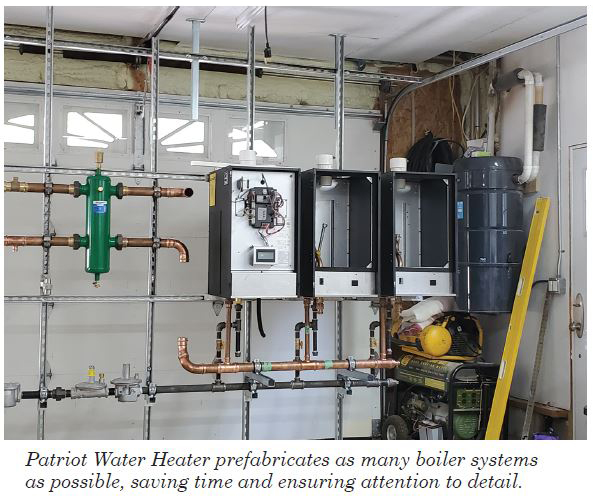
I realized this a while ago and started making changes in the way my company operates. The big turning point, though—the “lightbulb” moment, as some would say—came when I first pre-fabricated a boiler system.
These days, 90% of the boiler systems we install are pre-assembled in the shop after carefully measuring the mechanical space and taking many photos of the area in which the system needs to fit. We’ve found that this creates a better final product, reduces our time on-site, cuts overall labor by 20% and drastically curtails system downtime during the retrofit.
Room (and time) to work
Our prefab shop has plenty of space and plenty of light. Working on a table or stand means we’re not stooping over or resting on our knees. Big equipment/tools are already in place, so we’re not wasting time with setup and tear-down. We have jigs and spacers for a variety of system types and sizes, depending largely on the number of boilers in a system (more on that later).
The shop offers a relaxed atmosphere; no customers watching, no other trades fighting over power outlets, no messes, no weather considerations, no loud noises, etc. This all means greater attention to detail. Burn permits and fire watch are also a thing of the past. Hydronic racks are accessible from all sides, unlike working against a mechanical room wall.
We make our racks out of unistrut and build the system up from there. If the system is meant to heat a pool, or will be exposed to other caustic environments, we use stainless steel rack material.
We preassemble the entire boiler system to include wiring and all components. Everything is assembled loose and will be press connected later in the field. Once the system is complete, we take pictures, label everything with tape, put it in a box and reassemble it on-site like a simple jigsaw puzzle.
Cost, redundancy, turndown
Prefabbing boiler systems makes my company more competitive and provides a better product. Plain and simple, it just makes the job easier. Through the process of developing our pre-fab methods, we found another trick to add value to our commercial and multi-family installations.
Prefabricating boiler systems makes it easy to install multiple condensing boilers. We’ve found that it’s less expensive, per British Thermal Unit (BTU), to install multiple, small boilers than a single big one.
For example, many of the systems we replace require somewhere in the neighborhood of 450 to 550 thousand BTU per hour (MBH). In those situations, we fabricate hydronic systems with three U.S. Boiler Company K2 condensing boilers. If we need less firepower, we can drop to a smaller model. Need more heat? Add more boilers!
As I mentioned, equipment cost per BTU is usually slightly lower with multiple boilers, but there are many other advantages, such as redundancy with multiple boilers. The units are physically easier to handle. Turndown ratio goes way up. In the case of the K2 boilers, three boilers provide a full 30:1 turndown. Pair that with 95% annual fuel utilization efficiency (AFUE), and we’re talking about some major energy efficiency.
All that turndown also means that we can be more flexible in our boiler sizing. By properly staging the units through the K2’s Sage controls, the boilers will be running long hours at minimal input. That’s the perfect recipe to low fuel use and long boiler life cycle.
Multiple boiler installations are preferred for these many reasons, but can become a major headache and piping mess in the mechanical room without a solid design and the ability to prefab system components.
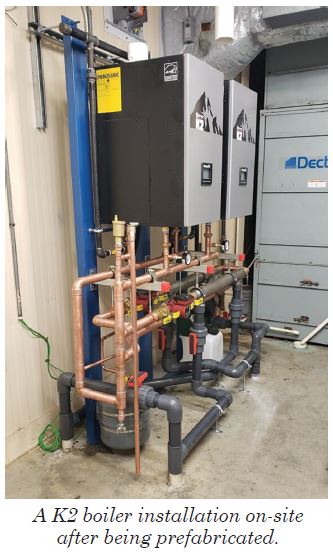
Customer satisfaction
For just a moment, forget about cost and efficiency. Just focus on the customer experience provided by a company that prefabs their boiler systems. It’s here you’ll find the biggest selling point for most commercial facilities, where time is critical and managers are extremely busy.
For example, we were recently hired to replace the boiler system at a retirement facility. We erected the entire system in our shop weeks before demolition day. On day one of the actual install, we had the old system torn apart, all of our racking installed and piping started. Day two had the boilers in place and fired. Day three included the finishing touches, control details and customer orientation. That can only be done through prefabrication.
Beyond speed, prefabbing boiler systems has other advantages. Building the system before the project starts eliminates change orders. Also, we take full accountability of the system, eliminating the footwork and orchestration needed on the customer’s part. They don’t need to be concerned about an electrician, a plumber and a gas tech, in addition to us. We provide one point of connection for each of these trades. ICM
———————————————————————————————————————————————————————————————————
Tom Soukup is the Principal of Patriot Water Heater Co. with more than 20 years as a hydronic designer and installer. He specializes in high-efficiency and Green technology and brings his expertise to custom commercial work, pool heating and agricultural projects. Email him at: twsoukup@patriotwaterheater.com
There have been a lot of creative ways to provide emergency heat to buildings during no-heat situations, but maybe none as original as a project completed earlier this year at an upscale rural property near Reading, PA.

The 12,500 sq ft building, one of many on the 100-acre property, houses a heated pool, spa, full-sized tennis court, kitchen and locker rooms. When the old sectional boiler used to heat the facility failed mid-Winter, maintenance staff turned the pool water temperature way up. This not only held the natatorium at a safe temperature, but waste heat from the pool heating equipment kept the adjacent tennis court from freezing.
Mechanical contractor Summers & Zims in Atglen, PA, was called in January to handle the no-heat call. The 37-person company had previously served the property owner in 2013 for an installation of an extensive snowmelt system.
Joe Henderson, Plumbing Project Manager, responded to the call and found that the large boiler was beyond repair; a replacement was needed immediately.
“Jason Richards, at Hajoca, and I began designing a replacement,” said Henderson. “There was a 500-gallon fuel oil tank on the property for the hydronic system and backup generator, and there was also a liquefied petroleum (LP) tank for the pool heater.
“The problem with replacing the original oil boiler with a propane unit was that the existing LP tank wasn’t large enough to handle the additional load. Plus, a second LP tank wasn’t immediately available.”
It became the first instance wherein major product availability issues would impact design process decisions for the companies. Luckily, the supply chain challenges ultimately resulted in a better system than originally planned.
Collaborative design
The design became a multi-boiler approach. The original plan was to install a single large sectional boiler, but, again, supply chain issues caused some trouble. After consulting with Dave Raabe at ROI Marketing, the companies learned that the boiler they wanted wouldn’t be available for a few weeks.
“This project took place at the height of the product availability challenge,” said Raabe. “The larger boilers weren’t available, so we looked at using three smaller MPO-IQ boilers, made by U.S. Boiler Co.
“These were immediately available. Ultimately, installing three boilers provided three stages of heat input for higher efficiency, and it also provided a level of redundancy. The smaller boilers also meant that the units could be wheeled into the mechanical on hand carts, instead of being field-assembled.”

As a result, the design team selected three 189 MBH boilers.
“We’ve come to love the MPO-IQ,” said Henderson. At 87%, they’re an efficient, dependable oil boiler.”
This design yielded a three-stage oil-fired system, which is uncommon in a residential/light commercial application. It provided some redundancy and, more importantly, allowed the system to fire at lower input based on outdoor reset.
Controlling the boilers became the next question. Summers & Zims’ HVAC trainer and in-house tech support, Kenny Walker, has a great deal of experience with tekmar controls and had used the tekmar Boiler Control 274 for staging multiple boilers on numerous occasions. The property owner also wanted to remotely monitor the system through Wi-Fi, so the new tekmar Smart Boiler Control 294 was selected.
Rapid installation
Summers & Zims (originally Summers Brothers Plumbing & Heating) has been in the business since 1930. They merged with Zim’s Sales & Service in the 1970s, forming the company it is known as today.
Summers & Zims employees are known as “do the right thing” kind of people. Joe Henderson is a knowledgeable hydronics guy. When it came time to install the system in a hurry, it was clear the company could handle it.
For the install, Walker was joined by Todd Lease, head plumbing technician; Andrew DiEugenio, journeyman plumber; and Austin McGhee, apprentice. The boilers were rolled into the mechanical room and a primary-secondary piping configuration was used to connect them to the system loop. The fuel supply line to each boiler features a Tigerloop fuel oil deaerator.
“We install a Tigerloop on every oil-fired system we install,” said Walker. “They cut down on nonsense service and emergency calls by cleaning up ignition and burn, which creates less soot in the heat exchanger. We also like that they allow us to use spin-on oil filters, which catch small dirt particles and reduce nozzle failures.
“If the homeowner isn’t attentive to the amount of fuel they have left in the tank, running empty isn’t such a big deal,” he added. “The Tigerloop provides a two-pipe system from the oil pump to the unit. This way, the oil pump will self-prime, meaning the owner or the fuel delivery tech can simply hit the reset button on the primary control once oil has been delivered.”
Flexible fuel lines were used from the Tigerloop to the boiler’s Beckett burner. To provide easy access to the three-pass heat exchanger, the MPO-IQ features a hinged front door, where the burner is located. By using flexible lines instead of hard pipe, service techs can open the boiler without removing the fuel fitting at the burner.

“Providing deaeration is even more critical on a multi-boiler installation like this because, the more times you tee off of the fuel line, the more opportunity there is for air to enter the fuel supply,” continued Walker.
Venting the boilers was done as deliberately as supplying the fuel. The existing chimney was large enough, but common venting the three units had to be done carefully.
“We couldn’t just run three, six-inch vents into a common stack, because the distance between the boilers and the main stack were slightly different,” explained Henderson. “The first two boilers join into an eight-inch vent, which increases to 10 inches as it picks up the third boiler and exits to the chimney.”
Control
When the original boiler failed, the property owner decided that he wanted to monitor the heating system regardless of where he was, and he also made the decision to sign a service agreement with Summers & Zims. For both of those reasons, Henderson wanted to find a control solution to stage the boilers and provide web-based monitoring; they also wanted to avoid the use of a complex, costly building automation system.
“Jason had recently told us about the new tekmar 294,” said Walker. “So when we bought the boilers from Hajoca, we also bought the control. The 294 is similar to the 274, but with more features, a touch screen, and most importantly, remote monitoring capability. It can also send me texts, emails and push notifications for a wide variety of alerts.”
The control stages and rotates the boilers, as well as handles outdoor reset, domestic hot water (DHW) priority, warm weather shutdown, etc. In a typical MPO-IQ boiler installation, the onboard boiler control features optional plug-and-play cards to provide outdoor reset, low-water cutoff and aquastat. In this system, the tekmar 294 replaces all but the low-water cutoff card.
“The 294 was easy to install, and I can pull up and make setpoint changes to the customer’s system at my office or on my phone,” said Walker.
Within a week of the old boiler failing, the new hydronic system was heating the building, and the pool heater was turned back down to its normal operating temperature.
This job—and the speed at which it came together despite supply chain issues—is a testament to contractors like Summers & Zims, who show up and do the very best they can. ICM
J.K. Holton, a construction company in Cochranville, PA, began as a business specializing in log homes in 1991, eventually growing into a full-service building and remodeling company. Its current owner, Tim Holton, took the reins from his father in 2015 and has since shifted the company’s focus.
“I’ve worked for Dad since I was 16, and by 2015, I’d reached a point in my career where I was either going to start my own company or take over the family business,” said Holton. “We decided that I would take over the company and he would step back into a support role. He’s still part of the company, when needed.”
Today, the company’s focus is almost entirely on additions and renovations. Holton has found that they can be more specialized this way. They also appreciate the opportunity to make improvements to existing homes instead of fighting over new construction jobs and dealing with the scheduling hassles that are inherent to a project that includes as many as a dozen different subcontractors.
“I live by three precepts that I inherited from my father,” Holton continued. “You can’t outlive a bad reputation. Under-promise and over-deliver. Cheap work ain’t good and good work ain’t cheap!”
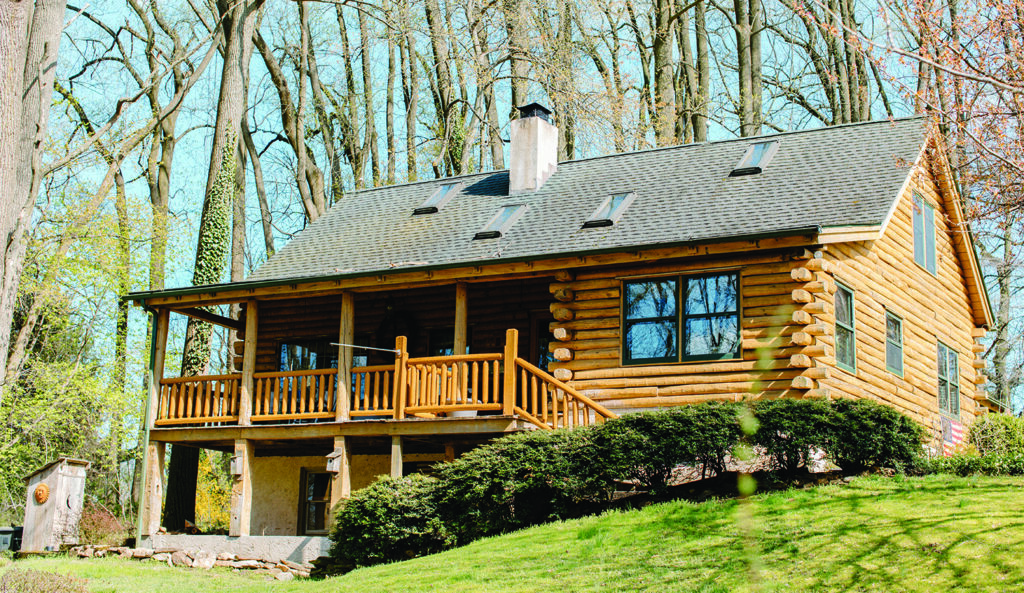
The log home hadn’t been renovated in decades.
Log home retrofit
J.K. Holton has forged a distinguished reputation in Southeast PA by living up to promises while providing crystal clear communications with everyone involved, from the homeowner to “subs.”
“It’s rewarding to visit a customer after a renovation and they’re just over the moon excited about how we’ve artfully refreshed or expanded their living space,” said Holton. “For example, the most recent log home we’ve worked on hadn’t changed in a long time; the upstairs bathroom hadn’t been touched since 1978.”
One of two bathrooms in the 2,400 sq ft home, the upstairs guest bathroom, is 80 square feet and had a simple bathtub and surround. The owner wanted to update it completely; new floors, vanity, tile shower and floor warming.
“We rarely take on small bathroom projects,” added Holton. “As a company, we specialize in larger remodeling work, which usually includes bathrooms. On average, 60% of our projects include a bathroom remodel. However, we took this job between two bigger jobs.”
J.K. Holton uses Creative Ceramics, LLC for much of its tile work. The company has been in business in the greater Newark, DE, area for nearly 20 years and is typically booked-out six months in advance. Given the log exterior wall in the bathroom and the use of an electric floor warming system, Holton preferred to sub-out the shower and flooring to Creative Ceramics.
“Mark Matchen, who owns Creative Ceramics, is without question the best tile setter I’ve ever seen,” said Holton. “Dad taught me early on to let people who specialize in a trade do that trade. I’ve seen Mark quickly and meticulously scribe natural stone tile to intricate crown molding. His work is always impressive.”
The bathroom was demolished and new plumbing was roughed-in before Matchen arrived to install underlayment.
“I always get the customer involved during the design,” Matchen said. “I prefer they see the tile laid out before it’s installed. We have one shot at getting it right. This homeowner really wanted two things—patterned tile and warm floors.”
Installing radiant floors
Matchen used Watts’ SunTouch electric system to provide the floor warming that the customer wanted. Due to the small size of the bathroom, he selected the SunTouch TapeMat. Electric wire is woven into the mat, allowing mortar or floor leveler to bond to the subfloor. After adhering the mat to the subfloor, Matchen poured floor leveler to bring consistency to the old log home’s bathroom floor. Then he ran wires to the touchscreen SunTouch thermostat on the wall.
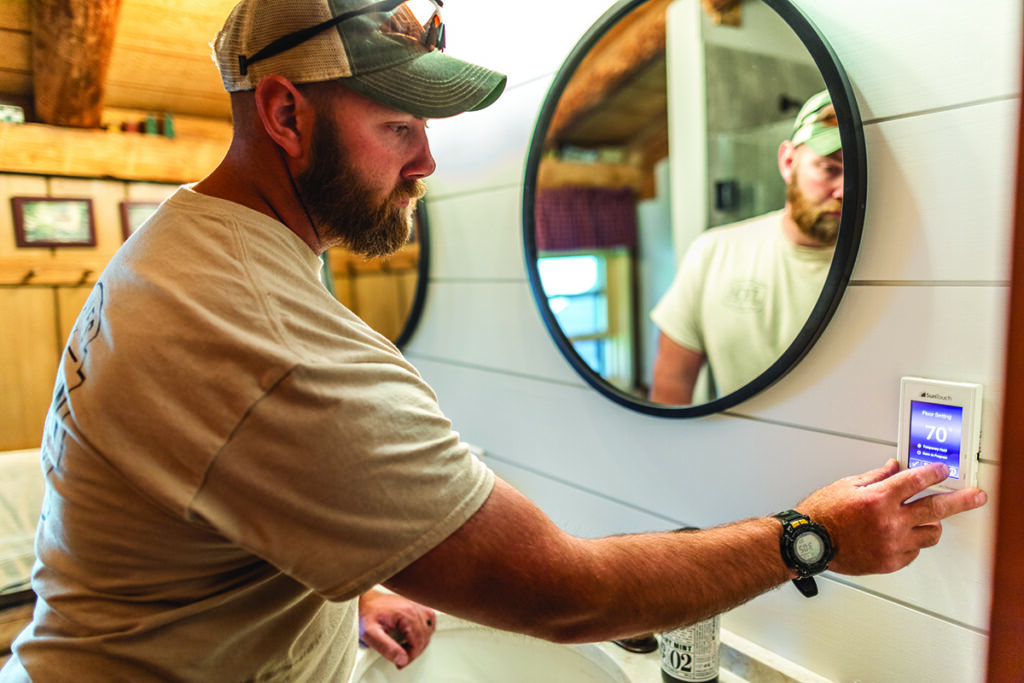
Tim Holton adjusts the floor temperature with the SunTouch thermostat.
There are a number of options when installing a SunTouch system beyond using the woven mat. WarmWire can be purchased on a spool and fastened directly to the floor. Alternately, the HeatMatrix uncoupling membrane can be installed, which allows the installer to snap wire into place. The polymer membrane has a fleece backing, which adds protection from expansion and contraction, especially when using large tiles.
“The SunTouch system is easy to install and you can make it fit any application and any size you need,” continued Matchen. “Floor warming is really the cherry on top for a bathroom remodel.”
After the floor leveler cured, Matchen installed the eight-inch patterned porcelain tile and completed the shower. A plumber arrived to install fixtures and Holton completed the vanity, trim and other finishes.
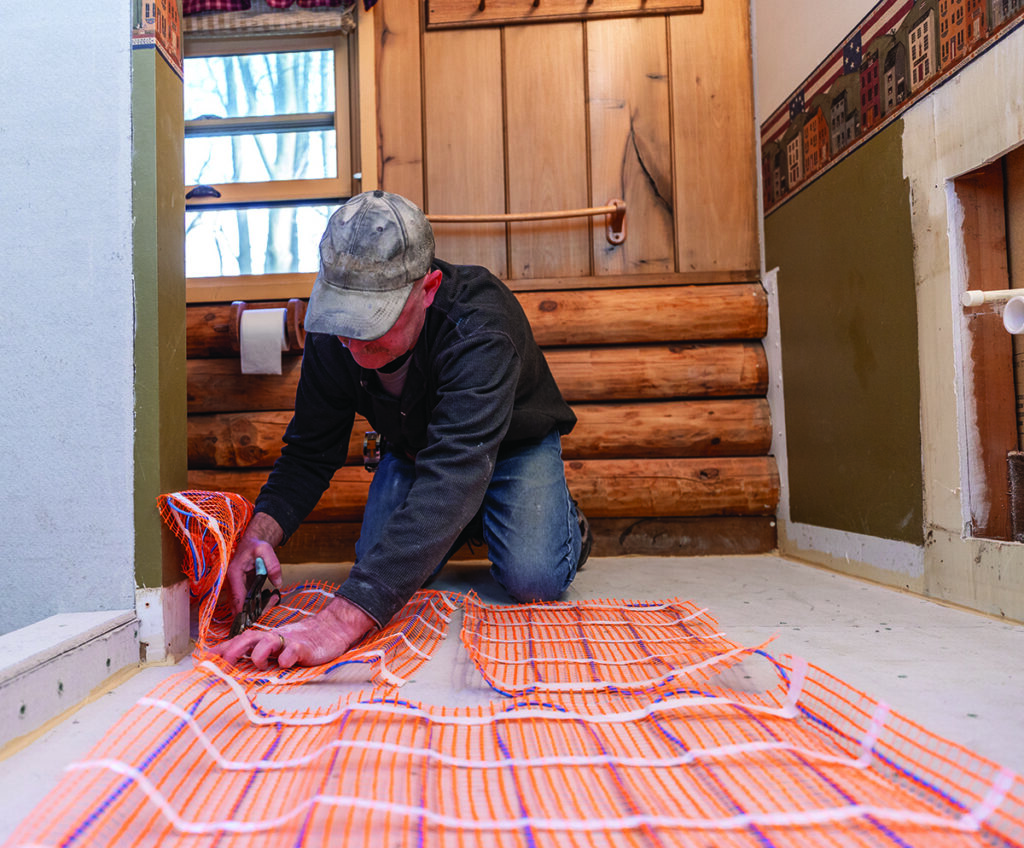
Mark Matchen installs the Suntouch TapeMat.
“Warm floors in any space, but especially a bathroom, takes the project to a whole different level,” said Holton. “About half of our bathroom renovations have warm floors. Five years ago there were not nearly as many. People are investing in premium comfort, and not just within super high-end residences. We’ve also installed floor warming in kitchens and sunrooms.”
The owner of the log home was thrilled with the result, from both aesthetic and comfort standpoints. Holton admits that installing warm floors and coordinating with a very busy, professional tile setter are just more steps in the process, but steps that are well worth it. After all, bathrooms and kitchen sell homes, or keep occupants in them.
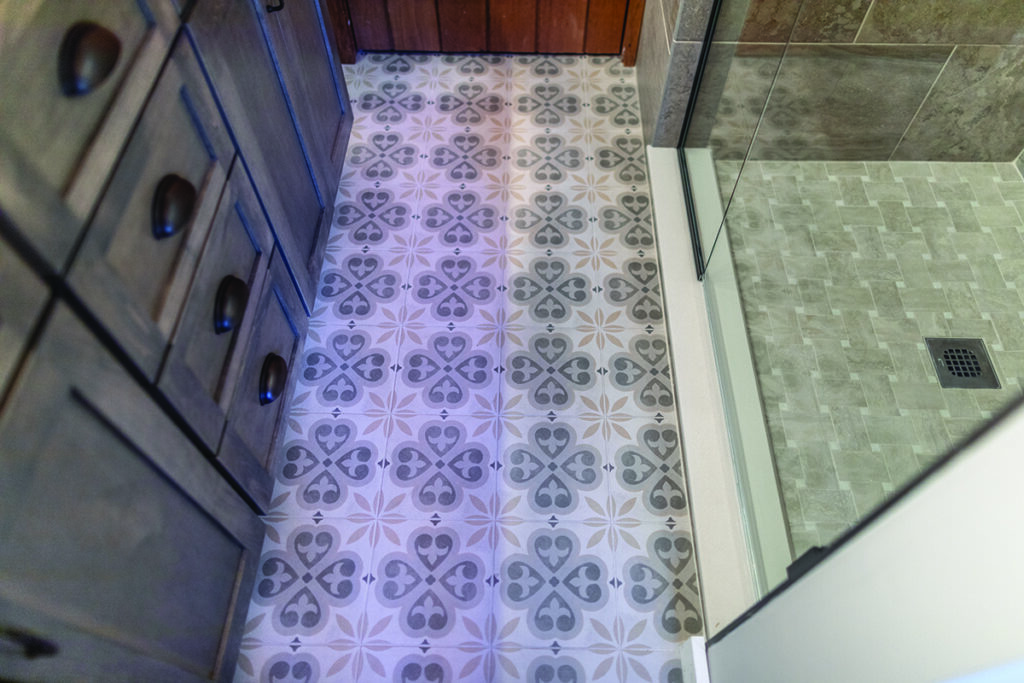
The finished bathroom floor.
According to Holton, there are few steps in the renovation process that, with relative ease and modest expense, add as much “wow” factor and contribute to lasting comfort as a radiant-heat floor that’s easy to control.
“The experience of bare feet on a warm tile or stone floor is hard to match when it comes to homeowner satisfaction,” concluded Holton. ICM
Dan Vastyan is PR director and writer for Common Ground, based in Manheim, PA.
Southern Florida’s tropical climate provides a number of design considerations, not the least of which is reducing humidity within the mechanical and conditioned living spaces—which is critical to ensure indoor air quality.
Even under normal operating conditions, preventing condensation and mold accumulation on ductwork and equipment located outside of the conditioned space can be a challenge. Making extraordinary demands of an ordinary cooling system can lead to a number of consequences from underperformance to mold growth. This was exactly the situation that Greg Borek found himself in after meeting homeowner Dr. Nils Nystrom.
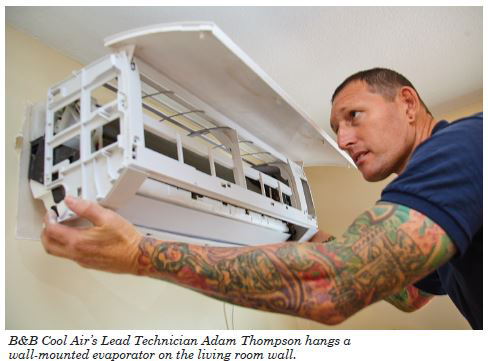
Borek is president of B&B Cool Air, based in Lehigh Acres, FL. He runs the 40-year-old cooling company with his brothers, Matthew and Frank Jr. They have 11 trucks on the road providing AC and commercial refrigeration service to the southwestern part of the state.
“When I met the Nystroms in mid-2019, they’d been without air conditioning for a few weeks while trying to find a contractor that could properly address their comfort issues,” said Borek. “Their previous 12-SEER unitary system had failed and they were running a portable cooler in the bedroom for the time being. The challenge was that they were adamant about maintaining indoor temperatures between 64°F and 73°F, and yet, they’re quite environmentally-conscious.”
The Nystroms are originally from Umea, Sweden, which is the latitudinal equivalent of Fairbanks, AK, roughly speaking. Both retired medical professionals, they’ve lived all over the world and throughout the U.S., generally selecting cooler climates when possible.
“Heat belongs in the sauna,” said Nystrom. “Growing up in Sweden, we’d sleep with the bedroom window open all winter long. We have a hard time sleeping if the bedroom is warmer than 18°C (64.4°F). Frankly, I don’t care for the climate in Florida, but it’s where our grandchildren live.
“Our search for a contractor spanned a few weeks,” he continued. “Nobody seemed willing to put forth the effort needed to create the indoor environment we wanted. We were finally referred to B&B Cool Air. Greg Borek is the consummate professional, and he did his due diligence after meeting us and seeing our home. He listened and presented options.”
Undersized and leaky
The 2,000 square-foot, 50-year-old home had been cooled by a three-ton, 12 SEER unitary system until the compressor failed. Not only was it undersized for the demand of keeping the house cooler than average, but the ductwork throughout the home was leaking.
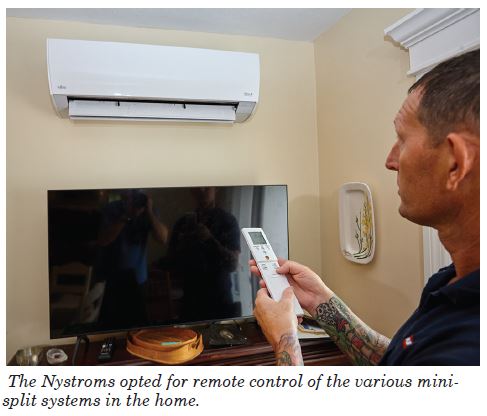 B&B Cool Air conducted a block load calculation, designing for a 66°F setpoint at an outdoor temperature of 95°F. The home required nearly five tons of cooling, which included duct loss.
B&B Cool Air conducted a block load calculation, designing for a 66°F setpoint at an outdoor temperature of 95°F. The home required nearly five tons of cooling, which included duct loss.
“At first, the Nystroms were adamant that they wanted a new unitary system,” said Borek. “We found that we could maintain temperature by installing a five-ton, inverter-driven unit and sealing or replacing the ductwork, but condensation on the ductwork and air handler was a real concern.”
The home sits right on the water, which adds to the challenge of Florida’s humid climate. All of the ductwork is run through a very small attic space. Borek suggested installing ductless heat pumps instead of a unitary system to avoid the condensation issue altogether, but the Nystroms wanted to further explore their unitary options.
“I explained that if there was to be a unitary system installed, we insisted on installing a dehumidification system in the attic in addition to sealing the ductwork,” said Borek. “What finally tipped the scales in favor of a ductless system was the ability for the Nystroms to conserve energy by cooling only the rooms they were using at any given time, instead of cooling the entire house. They liked the concept of letting unoccupied spaces idle at warmer temperatures for energy efficiency.”

“To us, the environmental advantage of cooling only unoccupied spaces is a tremendous benefit,” said Nystrom. “It makes very little sense to cool the entire house at any given time.”
Ductless meets the need
B&B Cool Air has been a Fujitsu Elite dealer since early 2019. Their loyalty to Mark Rambo, at Ferguson Fort Myers, initiated the switch to Fujitsu.

“Mark called on my Dad in the 1980s, and we’ve had an outstanding relationship since,” said Borek. “He actually has a contractor’s license, so he understands what he’s selling. When he made a transition to Ferguson last year, we switched to Fujitsu to stay with him, and it’s been a good move. Fujitsu multi-zone systems are easier to set up than the products we’ve used in the past, and the quality of product and the warranty are as good or better.”
Once the decision was made to use multi-zone ductless split systems, Borek zoned the home according to input from the Nystroms.
“We discussed where they spent most of their time and how cool they wanted each of the living spaces,” said Borek. “Ultimately, we installed two multi-zone systems, a two-zone and a four-zone; 18,000 and 36,000 BTUH, respectively.”
Work began in the master bedroom. Its wall-mount head, along with a smaller one in the guest bedroom, is connected to the smaller Halcyon condensing unit. After the bedroom systems were operational, several days passed before B&B could return to complete the rest of the installation. During that time, the bedrooms maintained setpoint while also keeping the rest of the home at a livable temperature.
The larger Halcyon model provides capacity to four wall-mounted evaporators ranging from 7,000 to 12,000 BTUH each, which cool the rest of the single-story home. These heads are in the dining room, living room, kitchen and study/office area. Installations We help more owners sell their business than anyone! Cetane Associates completes more transactions in the delivered fuels industry than any other M&A advisors. We bring more buyers to the table — an average of 5.8 offers per client. So you can choose the right deal for you, your employees, and your customers. Get to know us better at Cetane.net. Then call 860-592-0089 for a confidential conversation.
“Aesthetically, running linesets proved a bit tricky,” explained Borek. “The roof has an extremely low pitch, but we managed to get the lines into the attic area, insulate them well and drop down through the soffit to the condensing units. Once outside, the linesets and condensate lines are covered in aluminum line-hide.”
The dining room evaporator required the use of a condensate pump. Otherwise, all the indoor units were mounted on exterior walls, so the condensate can drain naturally. B&B Cool Air took a few extra steps to maintain consistent temperatures within the smallest areas of the home, where installing a mini-split head couldn’t be justified.
In the laundry, a small, low-speed fan draws warm air out of the room, discharging to the kitchen via a ceiling grille. As it does, conditioned air is pulled through the laundry doorway. This recirculation system can be controlled manually as needed.
Recalling Sweden
Over the first few months after the retrofit, the Nystroms contacted B&B Cooling multiple times to express their appreciation. The system was more comfortable and controllable than they’d expected.
“We’ve never been as comfortable in the home as we are now,” said Nystrom. “There’s no noise inside or outside. At worst, the sound level is a whisper. Greg’s honesty and experience were so apparent throughout the whole process, and we can’t say enough good things about his company.”
The Nystroms programmed the individual ductless heads to cool spaces according to their daily routine. The bedroom is cool while they sleep, the kitchen unit comes on when they wake up, and so on. They’ve found this to work very well, and can easily override the programming as they wish.
“When I was a child in Sweden, the town used to flood the soccer fields to create ice rinks over the winter,” said Nystrom. “In Phys Ed., we’d either skate or we’d find a hill and ski. Now, with climate change, it’s too warm for any of that. I contemplate these things when thinking of our changing world. One of the things I appreciate about the efficiency of our new Fujitsu system is that we can maintain a cool home with less impact on the environment than a conventional system.” ICM
Dan Vastyan is PR director and writer for Common Ground, based in Manheim, PA.
For better or worse, social media has had a profound and irreversible effect on society. Its impact has reached every business sector in the developed world. The skilled trades are no exception.
Some HVAC and plumbing manufacturers were quick to build a presence, although serious work-related adoption of social platforms by tradesmen and women took
some time. Now, however, the field has been populated by more than a few influencers who’ve differentiated themselves by regularly posting informational, interesting and humorous content that others in their trade can relate to.

TikTok and Instagram, specifically, have become peer-to-peer powerhouses, though the latter is far more widely used by tradespeople.
“Following other installers on Instagram has had a huge impact on my own work,” said Mike Flynn, Lead Installer & Job Supervisor for Service Professionals in northern New Jersey. “It pushed me to raise the quality of my work, especially from an aesthetic standpoint.
“You could plainly see the progress I made by comparing my own mechanical rooms to what I was seeing on social media,” continued Flynn. “I’ve probably learned the most on Instagram from Aaron Bond, Motty Pliers and Howard Mechanical, who I thanked in person at AHR [Air-Conditioning, Heating, Refrigerating Expo] 2020. The list goes on and on.”
Flynn really began posting to Instagram in 2015, about the time he started running jobs on his own. He goes by @flynnstone1 on the photo- and video-sharing app and has almost 17,000 followers.
His Instagram is populated by advice, tips, tricks and the rare tool review. Flynn’s French Bulldog, Bruce, makes a cameo appearance from time to time, and is even depicted in the caricaturized stickers he had made of his likeness. These stickers—in which Flynn is pictured with a giant pipe wrench and full arm sleeve tattoo—are traded with manufacturers and other tradespeople who use Instagram. The stickers he receives in return get applied to the inside of his van cab, acting as a backdrop when he records videos from the driver’s seat, or on the bins in the back of the van.
“Of course, 17,000 followers are insignificant for a celebrity or a big, household name company, but for a tradesman, it’s a very solid number,” said Flynn. “I appreciate my followers as much as I enjoy seeing other accounts that I learn from. I didn’t start posting in order to gain a big following. It kind of happened by accident. Once I hit about 1,500 followers, I realized I might have something unique.”
Opportunities
Flynn’s Instagram account is characterized by super clean work and things he encounters on a daily basis. He also posts what he calls Sunday Boiler School. He started these informative videos about two years ago.
“Sunday Boiler  School is a way for me to address what I see in the field being done incorrectly,” explained Flynn. “Steam boiler piping, circulator placement, venting, and circulator sizing—the latter being something I promote working on with a manufacturer if help is needed. I often contact Dave Holdorf, Eastern Region Residential Trainer at Taco Comfort Solutions, when I’m not certain of the pump curve I need.
School is a way for me to address what I see in the field being done incorrectly,” explained Flynn. “Steam boiler piping, circulator placement, venting, and circulator sizing—the latter being something I promote working on with a manufacturer if help is needed. I often contact Dave Holdorf, Eastern Region Residential Trainer at Taco Comfort Solutions, when I’m not certain of the pump curve I need.
“I know my lane within the Instagram community, and I do my best to stay in it,” added Flynn. “For that reason, I don’t offer advice on things I’m not really confident in or passionate about. I also don’t do many tool reviews.”
Having a robust social media presence has provided a number of opportunities for Flynn, whether to socialize, share information or improve his own skill set. He’s been a guest on a number of podcasts, including HVAC Know It All, Bold City Plumber’s “Bold Cast,” and HVAC Reefer Guy.
A photo that Flynn submitted to the Ridgid Tools brand in 2019—in which he’s stands atop a 550 MBH residential steam boiler with two pipe wrenches—earned him a ticket to the 2019 Ridgid Experience in Ohio.
On occasion, customers will recognize him from posts and ask, “Hey, you’re the Instagram guy, right?” However, this typically comes after a salesman has shown the customer Flynn’s Instagram.
“Service Professionals salesmen will sometimes use photos from my Instagram to show off our work to homeowners,” said Flynn. “So when they see the big guy with the beard and tats show up for the install, they sometimes draw the connection. Ultimately, my company likes that I’m active on social media. I’m careful not to let it interfere with my work.”

Ample education
As an employer, what’s better than a team member who actively seeks out his/her own training opportunities? That’s another advantage Flynn has found with social media. He’s always abreast of the training being offered by several different manufacturers.
Most recently, Flynn has attended Taco Comfort Solutions’ online training, which he learned about on Instagram. The company presents training materials in two live webinars.
The first is Taco Tuesday, a weekly webinar hosted each Tuesday at noon EST. The webinar alternates between residential and commercial topics. John Barba and Dave Holdorf host the residential courses while Rich Medairos and Brett Zerba host the commercial sessions.
Taco After Dark is presented weekly by John Barba, Dave Holdorf and Rick Mayo. The content from these webinars comes from Taco’s full-day hydronic courses, broken into one-hour segments.
“The webinars are great,” said Flynn. “I’ve met and learned from the hosts in the past. Dave Holdorf and John Barba are super smart and really funny.”
A recent Taco After Dark topic was whether to zone with circulators or zone valves, a topic that interested Flynn.
“My takeaway was that using valves or circulators is an entirely personal preference,” said Flynn.
“There are slight advantages in certain situations, like price point and redundancy, but it really comes back to sizing your circulator correctly for the demand. If you do that, the system will never be over- or under-pumped regardless of whether zone circulators or valves are used.”
More often than not, service professionals use valves to zone residential projects. Flynn speculates they do so only because that’s the way they’ve always done it. However, it wasn’t long ago that Flynn had the opportunity to install a lot of pumps in a single residence.
The Palace
“We arrived at a large residence in Upper Saddle River, NJ, to find a huge cast iron boiler, a 100-gallon, gas-fired water heater and 11 zones of baseboard, radiant, convectors and hydro coils, none of which were working properly,” said Flynn. “The owner only had three requests: replace it all, make it work and zone the house with circulators. That’s exactly what we did.”
The 9,500 sq ft home was served by a 20-year-old, 12-section boiler. Both it and the big water heater were due for replacement. The piping left a lot to be desired.
“You can argue all day about whether zone valves or zone circulators are better, but I think everyone will agree that you have to pick one or the other for a single zone,” said Flynn with a chuckle. “The zones on this system had zone valves downstream of the zone circulators. As you’d expect, the homeowner had all sorts of problems.”
Over the course of a week, the system was torn out and replaced, this time with two, 200 MBH condensing NTI boilers and an 80-gallon indirect tank. Primary/secondary piping was facilitated with a large hydro separator.
“We installed a Taco 007e ECM circulator on eight of the zones, with a pair of 0011s on the remaining two zones.” said Flynn. “The 007e was dependable, readily available and efficient. We install hundreds of them every year. The boiler circs are 0013s.”
Venting the job was the only challenge, given the mechanical room’s location in the middle of the beautifully finished basement. The joist bays ran the correct direction for combustion air and venting, but they would have terminated outside under a hardscaped stairway, so Service Professionals used the two existing chimneys that served the boiler and water heater.
“We ran both boiler exhaust vents through the existing boiler chimney with Centrotherm flexible poly vent lines,” explained Flynn. “The smaller chimney only allowed us to run one of the intake vents. The second boiler draws combustion air from the big mechanical room, and the owner leaves the mechanical room open. He likes to show the room off to his engineer buddies. He calls it ‘The Palace,’ and he’s really proud of it.”
When asked about the fuel savings provided by the retrofit, the owner admits that he doesn’t pay attention to his fuel bills. It’s safe to assume, though, that the reduction in natural gas consumption is substantial.
The job was gratifying for Flynn. He designed the system himself and headed up the install. Like many of his other mechanical rooms, the system is now immortalized on his Instagram account.

“Half of the work I do is hydronic, and half of that is steam,” said Flynn. “Last year we were installing four boilers each week. This year, for obvious reasons, we’re installing fewer. However, I’m keeping an eye on social media to see what others are doing as we emerge from the slow-down caused by the COVID-19 pandemic. Instagram is one way I can keep a pulse on things nationwide, and I’m hoping to see an uptick in boiler sales soon.” ICM
Dan Vastyan is PR director and writer for Common Ground, a trade communications firm based in Manheim, PA
A grassroots effort that began in Missouri many years ago is changing lives across the U.S., and the world, one family at a time. Love INC—with a mission to mobilize churches and to transform lives and communities—has set its sights on improving the lives of families in poverty by offering “Homes for Hope,” transitional housing for those in need, entirely through volunteer effort.
Recently some good folks in the HVAC and hydronic industry learned about a Love INC Homes of Hope transitional housing project in Lititz, PA from a local affiliate based in Lancaster (loveinclancaster.org). The suburban 1970s home still had its original HVAC equipment, so it was well overdue for a mechanical makeover. The volunteers quickly saw an opportunity to help improve comfort levels, and energy efficiency, for the soon-to- move-in family of four.
Mechanical makeover
Early in the project, local volunteer Rick Thompson, a Warwick Township Homes of Hope committee member and St. James Catholic Church member, asked friend Douglas DeAngelis, LAARS Heating Systems’ Eastern Atlantic Regional Manager, for some advice to help at this new Homes for Hope property. Its HVAC system’s equipment—an old, inefficient and leaking air conditioning system, and the original gas-fired furnace—were testing their resolve.

The location for installation work, now a residence serving those in need.

Triangle’s Refrigeration Field Service Supervisor Chad Heisey (left) and Eric Weaver, Triangle’s Business Developer, set the Mascot FT boiler in preparation for near-boiler piping.

Eric Weaver prepares to commission the system.

Eric Weaver (left) and Janson Zima, Triangle’s HVAC Project Manager, take satisfaction in a job well done.